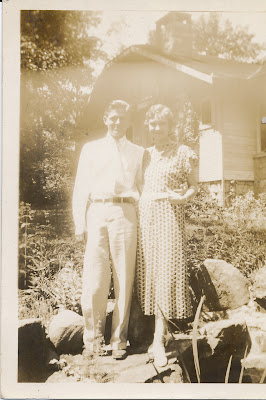April of 2009 was my last post to this blog. How quickly the time has gone by. I laid Ancestry.com, all research, the addiction, and The James Scroll aside to take a break. I didn't realize it would be this long before I dove back in, but I am very excited to be starting again.
I was absolutely amazed when I opened The James Scrolls at the number of "hits" (almost 21,000) and all the comments, which have been so wonderful for me. To each of you who took the time to read the posts and make comments, I offer a very heartfelt thanks. The information you gave and the validation in your comments left me soaring. When I first started this research, I knew I was part Cherokee, but I had no idea I would be able to trace so many Cherokee ancestors and have so many well-known ones in my line. It stupefied me, but in a wonderful way. I got carried away and posted some of the amazing Cherokees I learned about and was related to.
This time I want to start with my mother Thelma Roxanna James Reed to honor her and then try to post about and get to know her parents and grandparents and their ancestors who may not be as fascinating as Moytoy or Dragging Canoe, but hopefully will let me, my children,granchildren and future generations know more about our more recent relatives. As always, whoever might read these posts and can add to or correct any errors, please don't hesitate to comment.
So
Thelma Roxanna James Reed, born December 8, 1908, in Ottawa, Miami, Oklahoma, the sixth child of Lucinda Miller James, and Albert Blunt James.
In June of 1965 she applied`for a delayed birth certificate because there was not one on file in Oklahoma.
On this birth cerificate her color or race is listed as White and Indian. Both her parents were also born in Oklahoma.
The Thirteenth Census of the United States 1910 - Indian Population

Information Extracted As Follows:
Oklahoma
Ottawa County
Narcissa Township
May 9 , 1910
Name:
Thelma James
Age in 1910: 1year 5 month
Estimated Birth Year: abt 1909
(The census estimates instead of asking) Mom was 1 5/12 born in 1908
Birthplace: Oklahoma
Relation to Head of House: Daughter
Home in 1910: Narcissa, Ottawa, Oklahoma
Marital Status: Single
Race: Indian (Native American)
Gender: Female
Father's Name:
Albert James, Head of Household, Male, Indian, 32, Born in Oklahoma, His Father was born in Missouri, His Mother born in Kansas, Farmer, General Farm, Could both read and write,Owned home, Free of Mortgage
Mother's Name:
Lucinda James Female, Indian, 29, Born in Oklahoma, Her mothers Birth Place: Arkansas, Her Father was born in Tennessee
Neighbors: View others on page
Household Members: Name Age
Albert James 32
Lucinda James 29
Cherokee James 10
Opal James 9
Calvin James 7
Mildred James 6
Eilleen James 4
Thelma James 1 5/12
Mark Evans 19
(Note: I imagine this is a farm hand)
Both parents and children listed themselves as 1/8 Indian and 7/8 White.
End of Census Information
There are 6 children on this Census. There were a total of 14 kids as follows.
Cherokee Marie James 1899 – 1995 (Cherry)
Opal Irene James 1900 – 1961
Calvin Dridge James 1902 – 1929
Mildred Drucella James 1903 – 1998 (Mill)
Eileen Allana James 1906 – 1981
Haskell Blunt James 1907 – 1907
Thelma Roxanna James 1908 – 1998
Paul Andrew James 1911 – 1991
Leila Stough James 1913 – 1984
Howard Woodrew James 1914 – 1942
Albert Blunt Jr. James 1917 – 1925
Virginia May James 1918 – 1980 (Jean)
Lorenzo Lee James 1920 – 2003 (Tiny)
William Penn James 1923 – 1947
There were 6 children older than Mom and 7 younger. I knew 7 of them but not William Penn who died in 1947, Albert Blunt Jr. who died in 1925, Howard who died in 1942, Haskell who died in infancy and Calvin who in 1920 was convicted with 2 other men of killing a Coast Guard patrol while smuggling rum into the US and was executed.
The death certificate of Calvin Dridge James 1902-1929 showing he was electrocuted in prison at the Western State Penitentiary in PA in January of 1929.




































